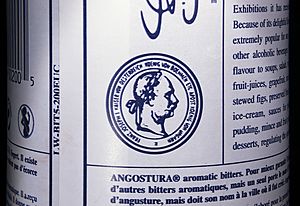Angostura bitters facts for kids
Angostura bitters is a special liquid used to add flavor to drinks and food. It is a type of bitters, which is a strong-tasting flavoring made from plants like gentian root, herbs, and spices. It is made by the House of Angostura company in the country of Trinidad and Tobago.
You can easily recognize a bottle of Angostura bitters. It has a bright yellow cap and a paper label that is famously oversized. The name "Angostura" comes from a town in Venezuela where the bitters were first made. The town was located at a narrow part of the Orinoco River, and "Angostura" is the Spanish word for "narrowing."
Even though it's called Angostura bitters, it does not actually contain bark from the angostura tree. Some other brands make similar products that do contain this bark.
Contents
History of Angostura Bitters
The recipe for Angostura bitters was created by a German doctor named Johann Gottlieb Benjamin Siegert. He was a surgeon general in the army of Simón Bolívar, a famous leader in South America. Dr. Siegert first made the bitters as a health tonic to help soldiers.
He started selling his creation in 1824 and opened a distillery in 1830 in the town of Angostura, Venezuela. He used local plants and herbs, possibly with help from the native people of the area.
In 1875, Dr. Siegert's sons moved the company from Venezuela to Port of Spain, the capital of Trinidad. The company is still there today.
A Famous Recipe
The exact recipe for Angostura bitters is a secret. Only a few people know the complete formula, and it is passed down through the family.
In 2007, the company also started making Angostura Orange bitters. This version has a fresh orange flavor.
In 2024, the company celebrated its 200th anniversary. The government of Trinidad and Tobago noted that bitters are an important part of the country's food and beverage exports.
How Angostura Bitters Is Used
Angostura bitters has a very strong and concentrated flavor. Because of this, it is almost never used by itself. Instead, just a few drops are added to drinks or food to give them a special taste.
Historical Uses
People once believed Angostura bitters could help with health problems. It was often used to help with an upset stomach. This is because one of its main ingredients, gentian root, is thought to help with digestion.
Some people used to mistakenly think the bitters were poisonous. This was because they confused it with angostura bark. In the past, some sellers would mix cheaper, unsafe barks with real angostura bark to make more money. However, the Angostura brand of bitters is safe and does not contain this bark.
In Drinks
Angostura bitters is a key ingredient in many famous drinks, especially cocktails. It was first used to help soldiers with stomach troubles, but it soon became popular when mixed with soda water and gin.
Today, it is used in many well-known drinks. For example, it is a classic ingredient in the Old Fashioned and the Manhattan. In some drinks, like the pisco sour, a few drops are put on top of the foam for decoration and to add a nice smell.
A very popular non-alcoholic drink in Australia and New Zealand is lemon, lime and bitters. In many other countries, people make a "rock shandy" by adding bitters to a mix of crushed ice and ginger ale.
The world's biggest seller of Angostura bitters is a place called Nelsen's Hall Bitters Pub on Washington Island in Wisconsin, USA. During a time in U.S. history called Prohibition, when selling most alcoholic drinks was illegal, the pub was allowed to sell shots of bitters as a "stomach tonic." This tradition continued, and today the pub is famous for it.
Popular Recipes with Angostura Bitters
- Champagne cocktail
- Cuba Libre
- Gunner
- Lemon, lime and bitters
- Manhattan
- Old fashioned
- Pink gin
- Pisco sour
- Rum punch
- Queen's Park Swizzle
- Rob Roy
- Singapore sling
- Trinidad Sour
- Zombie
See also
 In Spanish: Amargo de Angostura para niños
In Spanish: Amargo de Angostura para niños
- Gentian
- Meinhard's Bitters
- Peychaud's Bitters



